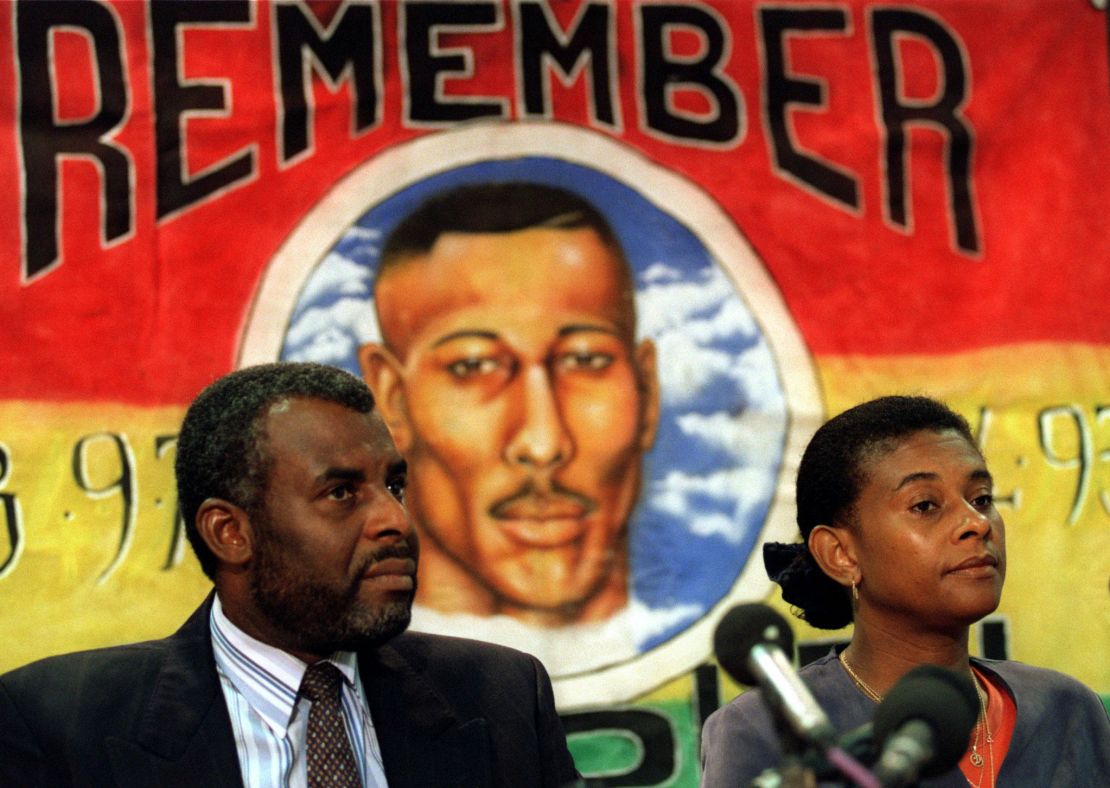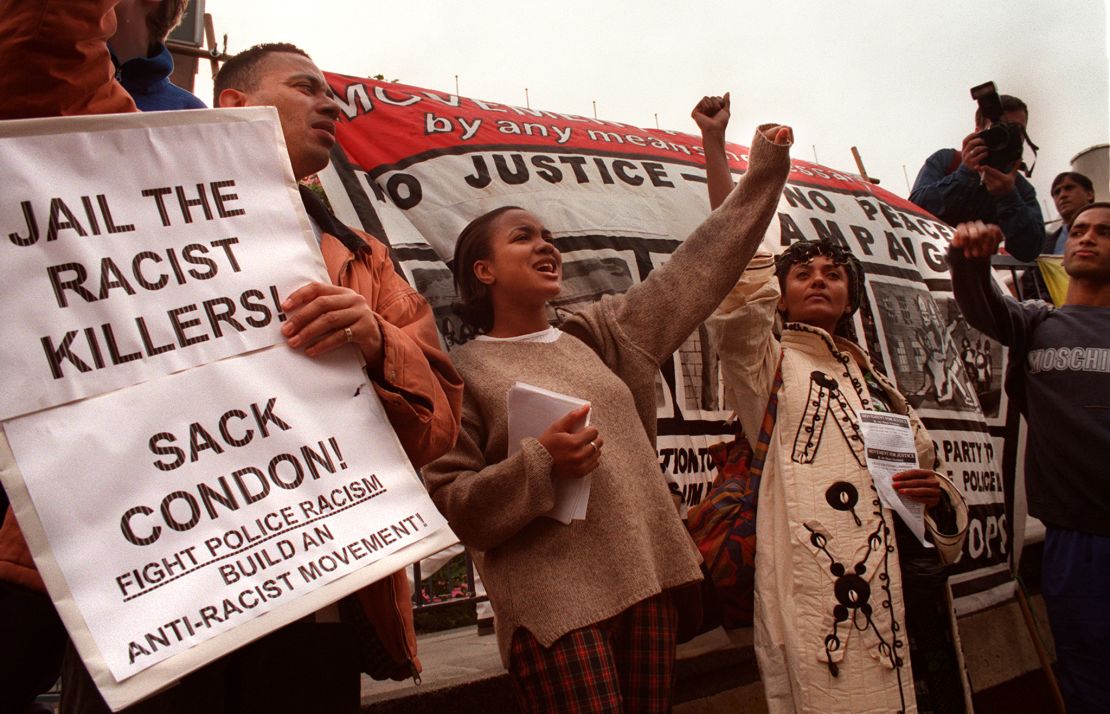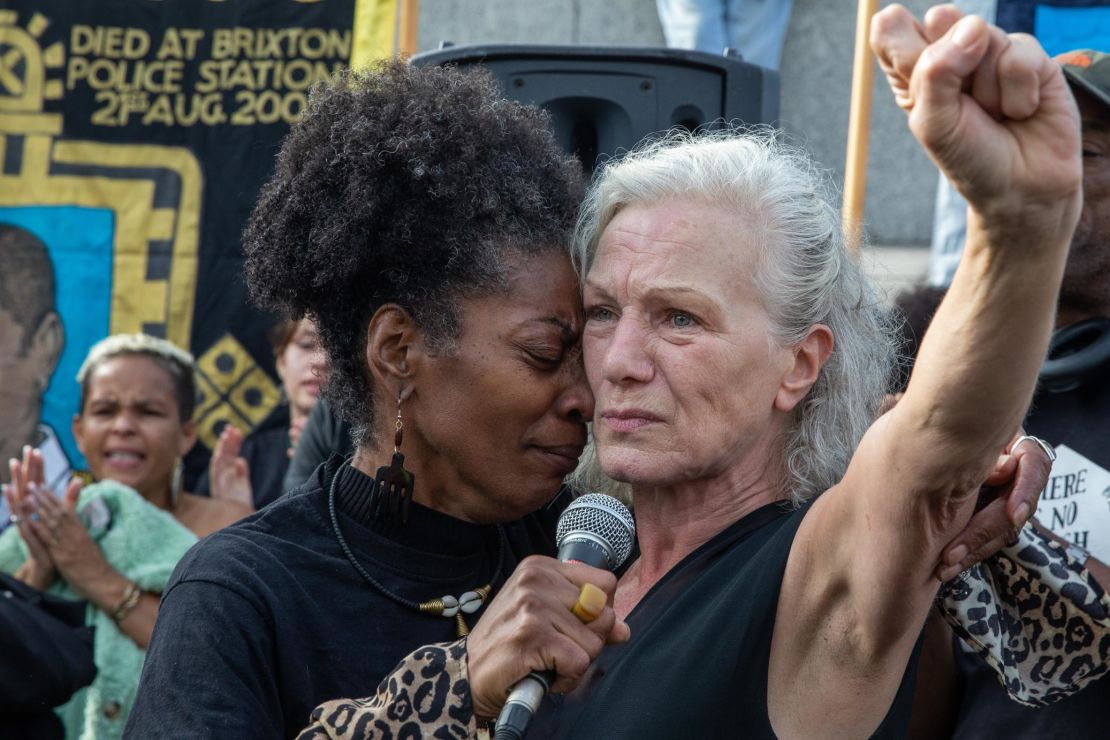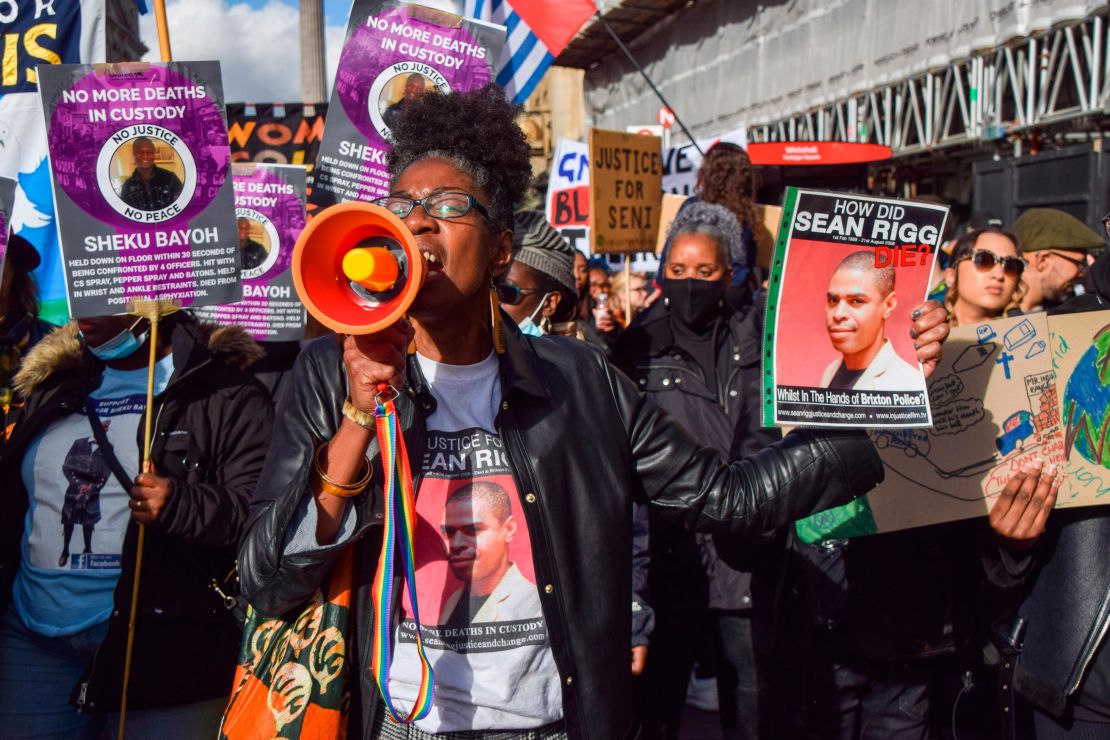Neville Lawrence sometimes imagines walking through London and looking at buildings his son Stephen might have worked on, had he lived long enough to fulfill his dream of becoming an architect. The closest he ever got to that was building a miniature.
“He did his work experience with an architect and he built a model of a building down in Deptford. So, every time I pass Deptford and see the building, it reminds me of him,” Lawrence told CNN, referring to a neighborhood in southeast London. It’s been 30 years, but he still gets emotional speaking about Stephen.
Stephen Lawrence was murdered when he was just 18 years old in a racially motivated attack on April 22, 1993. His killing and the subsequent failure of the London Metropolitan Police Service to properly investigate the crime sparked a national outcry. It culminated in a landmark official inquiry that concluded the force was institutionally racist.
But despite decades of promises, reviews and reforms, a new government report published last month, just four weeks before the 30th anniversary of Stephen’s murder, reached the same conclusion. The Met is still institutionally racist.
Raju Bhatt, a civil liberties lawyer who has dedicated his career to representing people making claims of wrongful conduct against the police, said nothing in the new report – the Baroness Casey Review – came as a surprise.
“What our clients see is a machinery which just doesn’t want to hear what they have to say and as a result, what happens is a failure to address the cultural problems, that culture of impunity, which arises when police officers know that they won’t be brought to account – when [they] know that whatever they do, their managers will be there to back them up, or, at the very least, their managers will look away,” he said.
The Met Police chief Mark Rowley has acknowledged “systemic” problems in the force but has so far declined to use the word “institutional.”


For Bhatt, the Casey report was just the latest development in a familiar cycle of events that began when he graduated from university in 1981.
That summer, racial tensions in Britain boiled over and sparked violent clashes between mostly Black protesters and the police, in south London’s Brixton neighborhood and elsewhere. Bhatt worked as a community volunteer, helping people who were arrested during the protests.
An official government inquiry into the riots and the police response concluded there was an “urgent need for changes in training and law enforcement and the recruitment of more ethnic minorities into the police force.” It also found that there was “evidence of harassment of minorities by some policemen.”
Stephen Lawrence was murdered 12 years after the Brixton riots. Within days of his killing at a bus stop in southeast London, five White teens were identified as being involved. They were arrested, but none was successfully prosecuted at the time.
It took years of campaigning by the Lawrence family — and public support from the likes of Nelson Mandela and the national press — to get the investigation moving. A 1997 inquest into Lawrence’s death found that he was unlawfully killed in a “completely unprovoked racist attack by five white youths.”
A wave of protests forced the then-government to commission an inquiry into the murder and the Met’s handling of it, which concluded in 1999 that “professional incompetence, institutional racism and failure of leadership by senior officers” was to be blamed for the botched investigation.
The review, known as the Macpherson report, made 70 recommendations on how to improve the police force and increase the public’s trust in the force. They included recruiting more Black and other minority ethnic officers to make sure the force reflects the communities it serves, taking steps to tackle disparities in the use of police powers against people from minority groups and developing specific guidelines on how to investigate and tackle racist crimes.
The Macpherson report was damning, but like the Brixton riots review, it failed to result in lasting and substantive reform of the Met Police.
More than a few ‘bad apples’
As a Black man who grew up in 70s and 80s Britain, Leslie Thomas says he knows what it’s like to be on the receiving end of police racism. He recounts how he has been racially profiled and stopped and searched by officers several times in the past, including once when he was driving with his wife and baby in the back of his car and once when he was just 14 years old.
“I was 14, in school uniform, coming home from school and a police van pulls up alongside me. Four officers jump out [and say] ‘you look suspicious’,” he said.
Like Bhatt, Thomas is a lawyer who has spent decades representing people in claims against the police and other public authorities. And, just like Bhatt, he has little faith that the latest report will lead to much change.
“Here’s the thing. You can’t hit a target unless you acknowledge the target itself. The Metropolitan Police have said, ‘oh, we want to be a more inclusive organization,’ but steadfastly, they refuse to acknowledge through their leadership that they’ve got a problem with institutional racism,” Thomas said.
“If it were just a few bad apples, then you wouldn’t expect, as we have seen, repetition after repetition, generation after generation,” he added.
The Met has not yet responded to CNN’s request for comment. But speaking to the London Assembly Police and Crime Committee last month, Rowley refused to label the Met Police “institutionally” racist, saying the word “institutional” is ambiguous and politicized.
In a statement released when the Casey report was published, Rowley said it “must be a catalyst for police reform” and “needs to lead to meaningful change.” He added: “I want us to be anti-racist, anti-misogynist and anti-homophobic. In fact, I want us to be anti-discrimination of all kinds.”
Thomas specializes in representing families of people who have died in police custody – an issue that disproportionately affects people of color.
Black people in the UK are seven times more likely to die from police restraint than White people, according to statistics compiled by Inquest, a charity that focuses on deaths in police and prison custody, immigration detention, mental health settings and other state settings.

Thomas represented the family of Sean Rigg, who died in 2008 after being pinned down in a police arrest while experiencing a mental health crisis. While an initial investigation by then-police watchdog the Independent Police Complaints Commission cleared the police of any wrongdoing, the Rigg family kept fighting.
In 2012, an inquest jury found that Rigg died of cardiac arrest after being restrained in a prone position for approximately eight minutes and said the level and length of restraint used by the police was “unsuitable” and “unnecessary” and that this “more than minimally” contributed to his death.
In light of the findings, the police watchdog re-examined the case. But a police misconduct panel cleared five officers of gross misconduct in connection to Rigg’s death in 2019. One of those officers had earlier been acquitted of perjury relating to his account of events on the night Rigg died.
Marcia Rigg, Sean’s sister, is still fighting. She and her family have spent years watching CCTV footage of Sean’s last moments, trying to piece together what really happened. The process has been deeply upsetting and it hasn’t, so far, led to the justice she wants for her brother.
“It was four years before we had an inquest. And basically myself and my family, particularly me and my brother Wade, we had to become investigators ourselves … to see your loved one being treated in that way by officers that should be helping us. It’s traumatizing, it makes you angry,” she told CNN.
Rigg said she still dreads the police. “I hate the sound of (the sirens), I hate the sight of the uniform, what it represents.”
The death of George Floyd in Minneapolis in May 2020 brought back all of the trauma for Rigg. Like Sean, Floyd was held face down by police in a prone position. Former Minneapolis police officer Derek Chauvin kneeled on Floyd’s neck for more than nine minutes and was ultimately found guilty of murdering him.
But it also made her even more determined to fight. “When George Floyd died, and everybody witnessed that murder, (British politicians) were on the side of the people, (saying) that this can’t happen. I said, well, they need to look in their own backyard,” she said.

‘Lack of will’ to address wrongdoing
Deborah Coles, Inquest’s executive director, said the struggles of the Lawrences and the Riggs to get justice for their loved ones mirror the experiences of nearly everyone she’s worked with.
She said the “cultures of denial and defensiveness and delay” within official government agencies, as well as victim blaming and the tendency to demonize the victim’s family and community, add to families’ suffering in such cases, as does “this ongoing institutional denial about the fact that institutional racism is a live and enduring issue.”
Successive governments and police chiefs have dismissed the severity of the issue, she told CNN. “We’ve always said that one of the problems is that when it comes to looking at deaths (in custody), they see them as isolated incidents, rather than being evidence of a systemic, enduring issue. This is a systemic issue across police forces.”
The UK’s largest police force commissioned the latest independent inquiry in 2021, after a serving Metropolitan Police officer was convicted of the kidnapping, raping and murdering Sarah Everard, a 33-year-old London woman. The eventual Casey report was damning, finding the Met not just institutionally racist, but also institutionally misogynistic, sexist and homophobic.
According to a separate parliamentary report published last year, Black people are more than nine-and-a-half times more likely to be stopped and searched than White people, even though the vast majority of “stop and search” actions don’t result in any further action.
The Met is still overwhelmingly White, with only 17% of officers identifying themselves as non-White in 2022, despite the city they police being far more diverse.
While that is more than the 3% figure recorded in the early 2000s, it is still well below its own targets and not at all reflective of the communities the police serve.
“We see time and again critical reviews, inquiries, inquest findings, coroner’s recommendations, a whole wealth of potentially lifesaving recommendations, but also very critical recommendations about structural changes needed. And yet there is no enforcement of those recommendations,” Coles said.
Inquest and other organizations are calling for a new oversight mechanism that would follow up and report on whether correct actions have been taken in response to the numerous inquiries, she added.

Finding peace
As the Lawrence family and their supporters mark the 30th anniversary of Stephen’s killing, they are still fighting for his killers to face justice.
It wasn’t until 2012, 19 years after the murder, that two of the five attackers – Gary Dobson and David Norris – were finally convicted and sent to prison. It took a change in law that allowed for a retrial in cases where new evidence is found.
To date, the other three people allegedly involved in the killing have not been brought to justice.
Neville Lawrence remains determined to keep fighting – although he said that the publication of the Casey report has made it clear to him, once again, that the family is on its own in this.
“If you want justice, you have to try and fight for it yourself, you don’t have anybody who is going to be doing it the way they should be doing it,” he said.
After years of being consumed by grief and anger, Lawrence decided to move back to Jamaica, where his son is buried. “I accept the situation where I had to leave this place so I can have some peace,” he told CNN.
“I couldn’t even bury my son here because of the vandalism that would have taken place. The amount of times that they vandalized the (memorial) plaque where he fell, that they had to put a camera on it to stop people going there and desecrating it … so just imagine Stephen, if he was here, what they would have done,” he said.
CNN’s Ivana Kottasová reported and wrote from London. Katie Polglase and Sarah El Sirgany reported from London.






